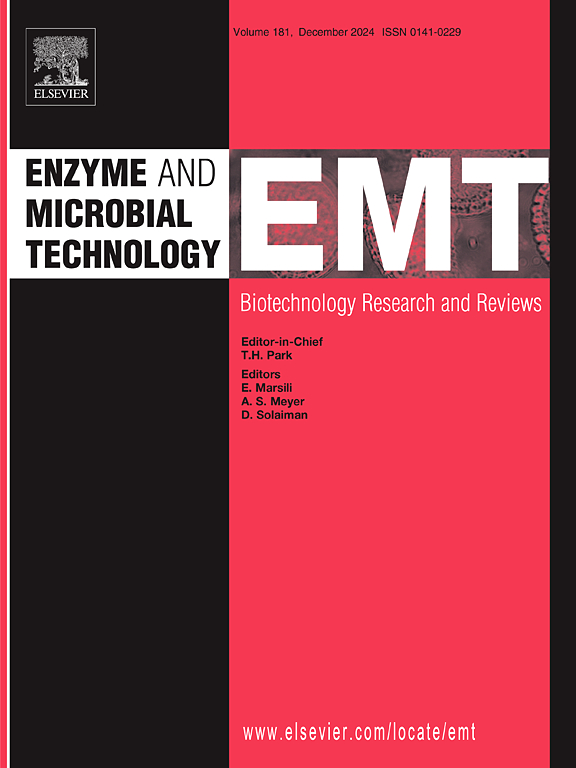不同丝状真菌翻译活性细胞裂解物的开发及其在无细胞蛋白合成中的应用。
IF 3.4
3区 生物学
Q2 BIOTECHNOLOGY & APPLIED MICROBIOLOGY
引用次数: 0
摘要
基于丝状真菌的无细胞蛋白质合成(CFPS)系统具有巨大的潜力,因为丝状真菌的培养简单、快速,而且大多成本低廉,具有很高的生物质时空产量和催化能力。在所研究的 22 种不同丝状真菌中,有 12 种真菌体外翻译了两种报告蛋白 GFP 和萤火虫荧光素酶中的至少一种。出现报告蛋白翻译的裂解液通常能够合成一种功能性无细胞表达的非特异性过氧化物酶(UPO),这种酶来自基枝菌 Cyclocybe (Agrocybe) aegerita。对于最有希望的候选菌冠突孢属(Neurospora crassa),研究人员研究并优化了培养和裂解物制备的不同条件对报告蛋白体外翻译的影响。一般来说,生长培养基的选择对翻译活性的提高最大,而添加有机氮则最为有益。通过优化 N. crassa 平台的培养和制备条件,萤火虫荧光素酶和 GFP 原始裂解物的蛋白质产量分别提高了 25 倍和 17 倍。除报告蛋白外,上述 UPO 以及黑曲霉的功能性 UPO 也利用 N. crassa 的不同裂解液进行了无细胞表达。使用真菌裂解物的 CFPS 为高通量和平行表达 UPO 打开了大门,例如,可用于优化合成条件或调整催化剂特性。该方法证明了真菌裂解物在无细胞合成中的普遍应用潜力。本文章由计算机程序翻译,如有差异,请以英文原文为准。
Development of translationally active cell lysates from different filamentous fungi for application in cell-free protein synthesis
There is an enormous potential for cell-free protein synthesis (CFPS) systems based on filamentous fungi in view of their simple, fast and mostly inexpensive cultivation with high biomass space-time yields and in view of their catalytic capacity.
In 12 of the 22 different filamentous fungi examined, in vitro translation of at least one of the two reporter proteins GFP and firefly luciferase was detected. The lysates showing translation of a reporter protein usually were able to synthesize a functional cell-free expressed unspecific peroxygenase (UPO) from the basidiomycete Cyclocybe (Agrocybe) aegerita.
For the most promising candidate Neurospora crassa, the influence of different conditions of cultivation and lysate preparation on in vitro translation of the reporter proteins was investigated and optimized. In general, the greatest improvements in the translational activity were achieved by the choice of the growth medium, the addition of organic nitrogen being most beneficial. Optimizing the culture and preparation conditions of the N. crassa platform improved protein yield of the original lysate by a factor of 25 for firefly luciferase and 17 for GFP, respectively. In addition to the reporter proteins, the aforementioned UPO as well as a functional UPO from Aspergillus niger were cell-free expressed using the different lysates from N. crassa.
CFPS with fungal lysates opens the door to expressing UPOs in high throughput and in parallel, for example to optimize synthesis conditions or adapt catalyst properties. The presented method proves the general potential of fungal lysates for application in cell-free syntheses.
求助全文
通过发布文献求助,成功后即可免费获取论文全文。
去求助
来源期刊

Enzyme and Microbial Technology
生物-生物工程与应用微生物
CiteScore
7.60
自引率
5.90%
发文量
142
审稿时长
38 days
期刊介绍:
Enzyme and Microbial Technology is an international, peer-reviewed journal publishing original research and reviews, of biotechnological significance and novelty, on basic and applied aspects of the science and technology of processes involving the use of enzymes, micro-organisms, animal cells and plant cells.
We especially encourage submissions on:
Biocatalysis and the use of Directed Evolution in Synthetic Biology and Biotechnology
Biotechnological Production of New Bioactive Molecules, Biomaterials, Biopharmaceuticals, and Biofuels
New Imaging Techniques and Biosensors, especially as applicable to Healthcare and Systems Biology
New Biotechnological Approaches in Genomics, Proteomics and Metabolomics
Metabolic Engineering, Biomolecular Engineering and Nanobiotechnology
Manuscripts which report isolation, purification, immobilization or utilization of organisms or enzymes which are already well-described in the literature are not suitable for publication in EMT, unless their primary purpose is to report significant new findings or approaches which are of broad biotechnological importance. Similarly, manuscripts which report optimization studies on well-established processes are inappropriate. EMT does not accept papers dealing with mathematical modeling unless they report significant, new experimental data.
 求助内容:
求助内容: 应助结果提醒方式:
应助结果提醒方式:


